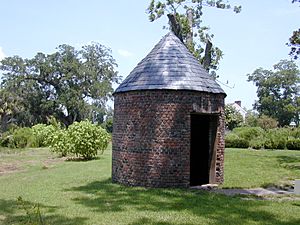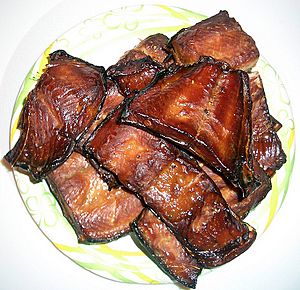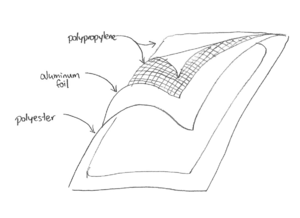Smoked salmon facts for kids
Smoked salmon is a delicious type of salmon. It's usually a piece of fish that has been treated with salt (this is called curing) and then smoked. Smoking can be done in two ways: hot smoking or cold smoking.
Because it costs a bit more, smoked salmon is often seen as a special treat. You might hear the word lox used for smoked salmon, but they are actually slightly different products.
Contents
Serving Smoked Salmon
Smoked salmon is a popular food for parties and snacks. It often goes well with cream cheese and a squeeze of lemon juice.
In places like New York City, smoked salmon is sometimes called "nova." This name comes from Nova Scotia, where some salmon used to come from. It's often sliced very thin and served on bagels with cream cheese. People also like to add sliced red onion, lemon, and capers.
In the Pacific Northwest (parts of the United States and Canada), smoked salmon can be found as thicker pieces or small chunks. Some types are smoked with hickory or alder wood. There's also "candied salmon," which is smoked and then glazed with honey or sugar. This is sometimes called "Indian candy."
In Europe, you can find smoked salmon sliced thin or in thicker pieces. Sometimes, it's sold as chopped bits for cooking. It's often used in tasty pâtés (spreads), quiches (savory tarts), and pasta sauces. Scrambled eggs mixed with smoked salmon is another popular meal. A strong-flavored smoked salmon salad might include iceberg lettuce, boiled eggs, tomato, olives, capers, and leeks, often with flavored yogurt.
Thin slices of smoked salmon are a favorite starter in Europe, usually served with bread. In the United Kingdom, it's often eaten with brown bread and lemon. In Germany, people eat it on toast or dark rye bread.
In Jewish cuisine, very salty salmon is called lox. It's usually eaten on a bagel with cream cheese. Lox is often smoked too.
Smoked salmon is sometimes used in sushi, especially in North America. The Philly Roll is a type of sushi that combines smoked salmon and cream cheese rolled in rice and nori (seaweed).
History of Smoked Salmon
Smoking fish helps keep it fresh for longer by protecting it from tiny living things called microorganisms. When salmon is smoked, it's cured and some of its water is removed. This makes it harder for bacteria to grow. For example, a harmful bacteria called Clostridium botulinum can be found in seafood. The high heat used in hot smoking kills this bacteria.
Smoked salmon has been important to many Native American cultures for a very long time. It was also a common food in ancient Greek and Roman times, often eaten at big parties. During the Middle Ages, smoked salmon became a regular part of people's diets and was used in soups and salads. The first known smoking factory was in Poland around 700 A.D. In the 1800s, the American smoked salmon industry grew on the West Coast. They processed Pacific salmon from Alaska and Oregon.
Smoked Salmon and Your Health
Salmon is a fish with healthy fats. Smoked salmon is a good source of omega-3 fatty acids, like DHA and EPA. These are good for your brain and heart.
However, smoked salmon has a lot of salt because of the curing process. For example, a small serving of smoked salmon has about 660 milligrams of sodium. The same amount of fresh cooked salmon has only about 50 milligrams. The salt helps keep the smoked salmon safe to eat by stopping germs from growing. But health experts suggest limiting how much salt you eat.
Smoked foods, including smoked salmon, also contain small amounts of nitrates and nitrites. These are created during the smoking process. Some of these can turn into other substances called nitrosamines, which might be linked to cancer. However, smoked salmon is not a major source of these substances for people.
Less Salt, Same Taste
Scientists have studied replacing some of the salt (sodium chloride) in smoked salmon with potassium chloride. They found that up to one-third of the salt could be replaced without changing how the smoked salmon tasted. Even though potassium chloride can taste bitter or metallic, the saltiness of the smoked salmon seemed to hide this flavor.
| Nutrient | Quantity per portion |
Percentage daily value |
|---|---|---|
| Energy | 120–140 kcals | |
| Energy from fat | 60 kcals | |
| Total fat | 6g | 9% |
| Saturated fat | 3g | 15% |
| Cholesterol | 40 mg | 13% |
| Sodium | 430 mg | 18% |
| Total Carbohydrates | 1g | 0% |
| Protein | 12g | 23% |
| Vitamin A | Trace | 2% |
| Vitamin C | Trace | 0% |
| Calcium | 11 mg | 0% |
| Iron | 0.85 mg | 3% |
| Sodium | 784 mg | |
| Potassium | 175 mg |
- Based on a 2,000 calorie diet – Serving size: about 3 oz or 85 g, cooked.
How Smoked Salmon is Made
In the Atlantic Ocean area, most smoked salmon comes from Atlantic salmon. Much of this fish is raised on farms in places like Norway, Scotland, Ireland, and eastern Canada. In the Pacific Ocean, different types of salmon are used. In Alaska, all salmon are wild Pacific species because fish farming is not allowed there. Pacific salmon types include Chinook ("King"), Sockeye ("red"), Coho ("silver"), Chum (keta), and Pink ("humpback").
Cold Smoking

Most smoked salmon is cold smoked. This means it's smoked at a low temperature, usually around 37 °C (99 °F). Cold smoking does not cook the fish, so it keeps a soft, delicate texture. Some smokehouses use a lot of smoke from oak chips for a strong "oaky" taste. But many factories use less smoke and cheaper woods to make a milder flavor.
In the past, workers would hang fish upside down on racks inside a smokehouse. Small fires of wood chips would burn slowly on the floor all night. Sawdust was added to the fire to create more smoke and prevent open flames, which would cook the fish instead of smoking it. A skilled "master smoker" would decide how long to smoke the fish by checking it by hand.
Smoked salmon came to the UK from Eastern Europe. Jewish immigrants from Russia and Poland brought the smoking technique to London in the late 1800s. They smoked salmon to keep it fresh because refrigerators were not common. At first, they imported salmon from the Baltic Sea. But then they discovered wild Scottish salmon and started smoking that instead. Today, many smokehouses use modern methods, but a few traditional ones still exist.
Native peoples in the Pacific Northwest and Alaska have their own unique cold smoking style. This makes a dried, "jerky-style" smoked salmon. For centuries, this type of salmon was a main food source for many native groups. To keep it fresh for a very long time today, the fish is often pressure-cooked.
Hot Smoking
Hot smoking is often used for both salmon and trout. This method actually cooks the salmon, making it less moist and firmer, with a stronger taste. You can eat it like cold smoked salmon, or mix it into salads or pasta. Before hot smoking, it's important to treat the salmon with enough salt and dry its skin. This helps form a special layer called a pellicle. Without it, a white substance called albumin can ooze out as the fish cooks, which doesn't look very nice.
Curing Salmon
There are three main ways to prepare salmon with salt before smoking:
- Wet brining: The salmon soaks in a liquid mixture of water, salt, sugar, and spices for several hours or days.
- Dry curing: This method is common in Europe. Salmon pieces are covered with a mix of salt, sugar, and sometimes other spices. Dry curing is usually faster than wet brining because the salt pulls moisture out of the fish. This means less drying time is needed in the smokehouse.
- Injection: This is the least common method because it can damage the delicate salmon meat. It's the fastest way because the curing liquid is injected directly into the fish, making it cure quickly.
The salt changes the proteins in the fish, helping the salmon meat hold moisture better. Sugar also helps keep the smoked salmon moist. Both salt and sugar are also preservatives, which means they help the salmon stay fresh longer. Regular table salt (iodized salt) is not used because the iodine can make the fish dark and taste bitter.
Packaging Smoked Salmon
Canning
In British Columbia, Canada, salmon canning started around 1870. Canning quickly became the most popular way to preserve salmon. By the early 1900s, there were over ninety canneries. Sockeye and Pink Salmon are most often canned. Traditional canned salmon includes skin and bones, which are good sources of calcium and other nutrients.
Fish enzymes work best at about 5 °C (41 °F), which is the temperature of the water they live in. Fish also have many bacteria on their skin and in their guts. These bacteria multiply quickly after the fish dies and can spoil the fish.
To can salmon, the fish is cleaned and cut into pieces. These pieces are put into sterilized cans with salt water. The cans are then heated twice in a vacuum-sealed environment. Steam is used at a high temperature (121.1 °C or 250 °F) for 90 minutes to kill all bacteria. After heating, the cans are cooled with water, dried, and stored in a cool place. Before leaving the factory, they are checked to make sure the cans are sealed properly and the fish is safe.
Retort Pouch
Cooking food in a flexible "retort pouch" is a newer method. These pouches are made of several layers of plastic and aluminum foil. The process is similar to canning, but the food is in a pouch instead of a metal can or glass jar.
Good Things About Retort Pouches
- Salmon in retort pouches keeps more of its nutrients and good taste. This is because the thinner pouch heats up faster than a metal can.
- Pouched food can be eaten without heating, or it can be heated very quickly by putting the pouch in boiling water for a few minutes. This uses less energy than heating frozen foods. You can also heat pouched food in a microwave after taking it out of the pouch.
- Pouches are easier and safer to open than cans or glass jars.
- Salmon in pouches often has a firmer, drier, and chewier texture than canned salmon.
- Using plastic retort pouches for delicate foods like smoked salmon can greatly reduce the cooking time needed to kill microorganisms.
Things to Consider About Retort Pouches
- Sometimes, the color, vitamins, smell, and texture of salmon can change during the heating process for retort pouches.
- Pouches with aluminum foil cannot be put directly into a microwave. (However, new microwave-safe retort pouches are now being made.)
How Smoked Salmon is Labeled
In the UK, "Scottish smoked salmon" sometimes means salmon that was smoked in Scotland but came from somewhere else. Food safety groups suggest that such salmon should be labeled as "Salmon smoked in Scotland" instead. Labels must also say how the salmon was produced, for example, if it was 'farmed', 'cultivated', or 'caught' in the wild.
Smoked Salmon Jerky
Smoked salmon jerky is a dried salmon product that you can buy ready to eat. It doesn't need to be kept in the fridge or cooked. (Some smaller local producers make "fresh" jerky that does need refrigeration.) Jerky is often made from the leftover pieces of salmon from other smoking processes. Smoked salmon jerky goes through the most heat treatment of all smoked salmon products. But it still keeps its healthy omega-3 fatty acids.
How Jerky is Made
The two main ways to make salmon jerky are wet-brining and dry salting. In both methods, the salmon is cut into thin slices and kept cold for less than a day. After being skinned and frozen, if the fish is wet-brined, it soaks in a salt solution for an hour. Then the extra water is removed. After this, for both wet-brining and dry salting, ingredients like non-iodized salt, potato starch, or light brown sugar are added. Sometimes, preservatives are added to make the jerky last longer. The salmon is then chopped up with the added ingredients and shaped into thin strips. These strips are smoked for about twenty hours. Wet-brined jerky tends to be more tender and have more moisture than dry-salted jerky. Dry-salted jerky is tougher because it has less water. Both types of salmon jerky have much less moisture than raw salmon.
Jerky Packaging
Smoked salmon jerky is packaged in a way that keeps it sterile (free from germs). It's often put in a vacuum-sealed bag where all the oxygen has been removed. Or, it might be in a package where oxygen has been replaced with nitrogen to stop germs from growing. Because smoked salmon jerky is processed with high heat, it can be stored on a shelf without refrigeration. Depending on the packaging and if preservatives were used, smoked salmon jerky can last from six months to a year. Smaller local producers make "fresh" jerky that is not heat-treated and needs to be kept in the fridge.
Images for kids
See also
 In Spanish: Salmón ahumado para niños
In Spanish: Salmón ahumado para niños





